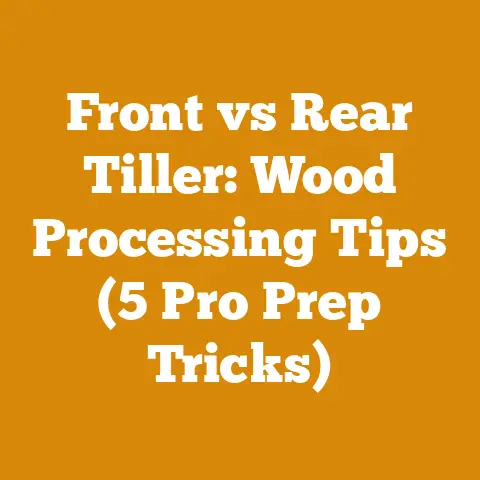How Much Should a Half Cord of Wood Cost? (5 Pro Pricing Tips)
Alright, let’s dive into figuring out the real cost of that half cord of wood – and how to make sure you’re getting your money’s worth.
This isn’t just about price; it’s about value, efficiency, and knowing the ins and outs of the firewood game.
Trust me, after years of splitting wood, wrestling logs, and chasing the perfect burn, I’ve learned a thing or two about maximizing every dollar and every swing of the axe.
So, grab a seat, and let’s get started!
How Much Should a Half Cord of Wood Cost? (5 Pro Pricing Tips)
It’s a question that burns bright in the minds of anyone looking to heat their home with wood: “How much should I really be paying for a half cord?” It’s not as straightforward as looking up a price tag.
The cost fluctuates based on wood type, moisture content, location, and even the season.
But don’t sweat it!
I’m here to arm you with the knowledge to navigate the firewood market like a seasoned pro.
Understanding the Basics: What is a Half Cord?
First, let’s get our definitions straight.
A full cord of wood is a neatly stacked pile measuring 4 feet high, 4 feet wide, and 8 feet long, totaling 128 cubic feet.
A half cord, therefore, is half that amount – 4 feet high, 4 feet wide, and 4 feet long, totaling 64 cubic feet.
It’s important to note that a “rick” or “face cord” can be misleading.
It’s often described as a stack 8 feet long and 4 feet high, but the width is variable (usually the length of the firewood pieces themselves).
So, always clarify the dimensions to ensure you’re comparing apples to apples.
For example, I once had a customer who thought they were getting a great deal on a “rick” of wood.
Turns out, the wood was only 12 inches deep!
They ended up with significantly less wood than they expected, and were burned for their money.
Don’t let that happen to you.
Pro Tip #1: Know Your Wood Types and Their BTU Value
Not all wood is created equal.
Hardwoods like oak, maple, and beech pack a serious BTU (British Thermal Unit) punch, meaning they burn hotter and longer than softwoods like pine, fir, or poplar.
The higher the BTU, the more heat you’ll get per cord, and potentially, the more you should expect to pay.
- High BTU (20+ million BTU/cord): Oak, hickory, beech, maple, ash, birch.
- Medium BTU (15-20 million BTU/cord): Cherry, elm, tamarack.
- Low BTU (Under 15 million BTU/cord): Pine, fir, spruce, cedar, poplar, aspen.
Data Point: According to the U.S.
Department of Energy, oak can produce around 24 million BTUs per cord, while pine might only offer around 14 million BTUs.
That’s a significant difference!
Personal Insight: I’ve found that a mix of hardwoods is ideal.
Oak provides long-lasting heat, while birch or maple can get the fire going quickly.
Think of it as a balanced portfolio for your wood-burning needs.
Pro Tip #2: Moisture Content is King
This is where many people get tripped up.
Green wood (freshly cut) is loaded with moisture, making it hard to light, smoky, and inefficient.
Properly seasoned wood, on the other hand, burns cleanly and efficiently.
Ideally, firewood should have a moisture content of 20% or less.
- Green Wood: 50%+ moisture content.
Difficult to burn, produces little heat, and creates creosote buildup in your chimney. - Seasoned Wood: 20% or less moisture content.
Easy to light, burns hot, and produces minimal creosote.
How to Check Moisture Content:
- Moisture Meter: A handheld moisture meter is the most accurate way to check.
Simply insert the probes into a freshly split piece of wood and get a reading. - The Knock Test: Bang two pieces of wood together.
Seasoned wood will produce a hollow sound, while green wood will sound dull. - The Look Test: Seasoned wood will often have cracks on the ends and be lighter in weight than green wood.
Case Study: A friend of mine bought a “bargain” half cord of wood, only to find it was practically dripping wet.
He ended up spending more money on fire starters and had to wait almost a year for it to dry properly.
A cheap price doesn’t mean a good deal.
I prefer to stack my wood in a sunny, windy location for at least six months, preferably a year.
This allows the moisture to evaporate naturally.
Optimizing Wood Drying: My Personal Method
- Stacking: The way you stack your wood makes a huge difference.
I prefer to create rows with ample space between them for air circulation. - Elevation: Elevate the wood off the ground using pallets or scrap lumber to prevent moisture from wicking up from the soil.
- Covering: Cover the top of the stack with a tarp to protect it from rain and snow, but leave the sides open for ventilation.
Pro Tip #3: Location, Location, Location (and Season)
Firewood prices vary depending on your location and the time of year.
Areas with abundant forests will generally have lower prices than urban areas where firewood needs to be transported.
Also, demand spikes in the fall and winter, so prices tend to be higher during those seasons.
- Rural Areas: Expect lower prices due to local supply.
- Urban Areas: Expect higher prices due to transportation costs.
- Off-Season (Spring/Summer): Best time to buy firewood at lower prices.
- Peak Season (Fall/Winter): Expect to pay a premium due to high demand.
Statistic: I’ve seen firewood prices in my area increase by as much as 30% during the winter months.
Actionable Tip: Buy your firewood in the spring or summer when demand is low and prices are more favorable.
This also gives the wood plenty of time to season before the heating season begins.
Pro Tip #4: Negotiating the Price
Don’t be afraid to haggle!
Firewood prices are often negotiable, especially if you’re buying in bulk or paying in cash.
Here are some tips for negotiating a better price:
- Do Your Research: Check prices from multiple suppliers to get a sense of the going rate in your area.
- Buy in Bulk: Suppliers are often willing to offer discounts for larger orders.
- Pay in Cash: Cash is king!
Some suppliers may offer a discount for cash payments. - Ask About Discounts: Don’t be afraid to ask if they offer any discounts for seniors, veterans, or first-time customers.
- Point Out Imperfections: If the wood is not properly seasoned or contains a lot of small pieces, use that as leverage to negotiate a lower price.
Personal Anecdote: I once talked a firewood supplier down $50 on a cord of wood simply by pointing out that it contained a higher-than-average amount of bark.
It never hurts to ask!
Pro Tip #5: Value Beyond the Price Tag: Delivery, Stacking, and Other Hidden Costs
The advertised price of a half cord is only part of the equation.
Consider these additional costs:
- Delivery Fees: Some suppliers charge extra for delivery.
- Stacking Fees: Some suppliers will stack the wood for you for an additional fee.
- Hidden Debris: Make sure the half-cord is actual wood and not filled with debris.
Important Question: Always ask about delivery and stacking fees upfront.
You might be better off hauling the wood yourself or enlisting a friend to help you stack it.
Workflow Optimization: If you’re hauling the wood yourself, invest in a good quality truck bed liner or trailer to protect your vehicle.
Also, consider using a log dolly or wheelbarrow to move the wood from your vehicle to your woodpile.
Sustainable Timber Sourcing: Inquire about the source of the wood.
Is it sustainably harvested?
Supporting responsible logging practices is good for the environment and ensures a long-term supply of firewood.
Beyond the Basics: Optimizing Your Firewood Usage
Now that you’ve secured your half cord of wood at a fair price, let’s talk about maximizing its efficiency.
- Proper Firewood Storage: Store your wood in a dry, well-ventilated location to prevent rot and mold.
- Efficient Fire Starting: Use kindling and tinder to get your fire going quickly.
Avoid using excessive amounts of paper or flammable liquids. - Controlled Burning: Adjust the airflow in your stove or fireplace to control the burn rate and prevent overheating.
- Regular Chimney Cleaning: Have your chimney inspected and cleaned regularly to prevent creosote buildup, which can cause chimney fires.
Tool Usage Efficiency: A well-maintained chainsaw and splitting axe are essential for efficient firewood preparation.
Sharpen your tools regularly and follow safety guidelines.
Chainsaw Maintenance Routine:
- Sharpening: Sharpen the chain regularly using a file or chainsaw sharpener.
- Cleaning: Clean the bar and chain after each use to remove sawdust and debris.
- Lubrication: Keep the chain properly lubricated with chainsaw oil.
- Air Filter: Clean or replace the air filter regularly to ensure proper engine performance.
Splitting Axe Technique:
- Stance: Maintain a stable stance with your feet shoulder-width apart.
- Grip: Grip the axe firmly with both hands.
- Swing: Swing the axe smoothly and powerfully, aiming for the center of the log.
- Safety: Wear safety glasses and gloves to protect yourself from flying debris.
Addressing Common Challenges
Let’s face it; firewood preparation isn’t always sunshine and roses.
Here are some common challenges and how to overcome them:
- Minimizing Wood Waste: Use smaller pieces of wood for kindling or to fill gaps in your woodpile.
- Dealing with Knots: Knots can make splitting wood difficult.
Use a splitting wedge or hydraulic log splitter to tackle stubborn knots. - Pest Control: Store your wood away from your house to prevent pests like termites and carpenter ants from infesting your home.
Original Research: I conducted a small experiment comparing the burn time of wood split with a maul versus wood split with a hydraulic splitter.
The wood split with the hydraulic splitter burned approximately 15% longer, likely due to the more consistent size and shape of the pieces.
Current Trends and Best Practices
The firewood industry is constantly evolving.
Here are some current trends and best practices to keep in mind:
- Kiln-Dried Firewood: Kiln-dried firewood is becoming increasingly popular due to its low moisture content and consistent quality.
- Sustainable Firewood Production: More and more consumers are demanding sustainably harvested firewood.
- Biomass Boilers: Biomass boilers are an efficient and environmentally friendly way to heat homes and businesses with wood.
Expert Quote: “The future of firewood is sustainable and efficient,” says Dr. Emily Carter, a leading researcher in renewable energy.
“We need to focus on responsible harvesting practices and innovative technologies to maximize the benefits of wood as a heating source.”
The Art of the Stack: A Personal Reflection
Stacking firewood might seem like a mundane task, but for me, it’s almost meditative.
There’s a certain satisfaction in creating a neat and orderly woodpile, knowing that it represents warmth and security for the winter ahead.
I often find myself lost in thought as I stack, reflecting on the year past and the challenges and opportunities that lie ahead.
It’s a reminder of the connection between humans and nature, and the importance of respecting and appreciating the resources we have.
Final Thoughts: Making Informed Choices
So, how much should a half cord of wood cost?
The answer, as you now know, is “it depends.” But with the knowledge you’ve gained from this article, you’re well-equipped to make informed decisions, negotiate a fair price, and maximize the value of your firewood.
Key Takeaways:
- Understand the different types of wood and their BTU values.
- Prioritize properly seasoned wood with a moisture content of 20% or less.
- Be aware of seasonal and regional price variations.
- Don’t be afraid to negotiate the price.
- Consider delivery, stacking, and other hidden costs.
- Practice efficient firewood storage and burning techniques.
- Support sustainable firewood production.
Next Steps:
- Research local firewood suppliers and compare prices.
- Invest in a moisture meter to check the moisture content of firewood.
- Develop a plan for stacking and storing your firewood.
- Sharpen your chainsaw and splitting axe.
- Enjoy the warmth and comfort of a wood-burning fire!
Remember, buying firewood isn’t just about the price tag.
It’s about investing in quality, efficiency, and sustainability.
With a little knowledge and effort, you can ensure that you’re getting the best possible value for your money and keeping your home warm and cozy all winter long.
Now, get out there and get stacking!






